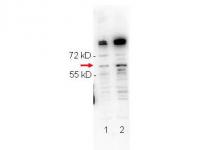NF-kB p65 (RELA) Rabbit Polyclonal Antibody
Other products for "RELA"
Specifications
| Product Data | |
| Applications | WB |
| Recommended Dilution | ELISA: 1:5,000 - 1:25,000, WB: 1:1,000 |
| Reactivities | Human |
| Host | Rabbit |
| Isotype | IgG |
| Clonality | Polyclonal |
| Immunogen | NFkB p65 (Rel A) peptide corresponding to a region near phospho Serine 276 of the human protein conjugated to Keyhole Limpet Hemocyanin (KLH). |
| Formulation | 0.02 M Potassium Phosphate, 0.15 M Sodium Chloride, pH 7.2 |
| Concentration | lot specific |
| Conjugation | Unconjugated |
| Storage | Store at -20°C as received. |
| Stability | Stable for 12 months from date of receipt. |
| Gene Name | RELA proto-oncogene, NF-kB subunit |
| Database Link | |
| Synonyms | NFKB3; p65 |
| Note | NF?B was originally identified as a factor that binds to the immunoglobulin kappa light chain enhancer in B cells. It was subsequently found in non-B cells in an inactive cytoplasmic form consisting of NF?B bound to I?B. NF?B was originally identified as a heterodimeric DNA binding protein complex consisting of p65 (RelA) and p50 (NFKB1) subunits. Other identified subunits include p52 (NFKB2), cRel, and RelB. The p65, cRel, and RelB subunits are responsible for transactivation. The p50 and p52 subunits possess DNA binding activity but limited ability to transactivate. p52 has been reported to form transcriptionally active heterodimers with the NF?B subunit p65, similar to p50/p65 heterodimers. Low levels of p52 and p50 homodimers can also exist in cells. The heterodimers of p52/p65 and p50/p65 are regulated by physical inactivation in the cytoplasm by I?B-a. I?B-a ?binds to the p65 subunit preventing nuclear localization and DNA binding. Activators mediate a rapid phosphorylation of I?B by I?B kinase (IKK) which results in subsequent ubiquitination and proteolytic degradation. NF?B is then transported to the nucleus, where it activates transcription of target genes through binding to NF?B target sequences within the promoter. The HTLV-I protein Tax can induce constitutive NF?B activation through phosphorylation of both I?B-a and I?B-β. The transforming protein Tax inhibits p53 transcriptional activity through the NF?B signaling pathway, specifically via the p65 (RelA) subunit. The inhibition of p53 activity is dependent upon phosphorylation of p65 (RelA) at S536 by the upstream kinase IKKβ. |
| Reference Data | |
| Protein Families | Druggable Genome, Transcription Factors |
| Protein Pathways | Acute myeloid leukemia, Adipocytokine signaling pathway, Apoptosis, B cell receptor signaling pathway, Chemokine signaling pathway, Chronic myeloid leukemia, Cytosolic DNA-sensing pathway, Epithelial cell signaling in Helicobacter pylori infection, MAPK signaling pathway, Neurotrophin signaling pathway, NOD-like receptor signaling pathway, Pancreatic cancer, Pathways in cancer, Prostate cancer, RIG-I-like receptor signaling pathway, Small cell lung cancer, T cell receptor signaling pathway, Toll-like receptor signaling pathway |
Documents
| Product Manuals |
| FAQs |
{0} Product Review(s)
0 Product Review(s)
Submit review
Be the first one to submit a review
Product Citations
*Delivery time may vary from web posted schedule. Occasional delays may occur due to unforeseen
complexities in the preparation of your product. International customers may expect an additional 1-2 weeks
in shipping.






























































































































































































































































 Germany
Germany
 Japan
Japan
 United Kingdom
United Kingdom
 China
China



